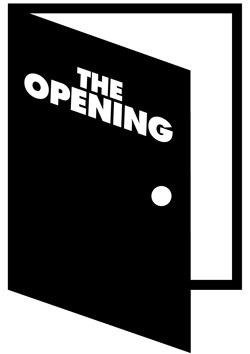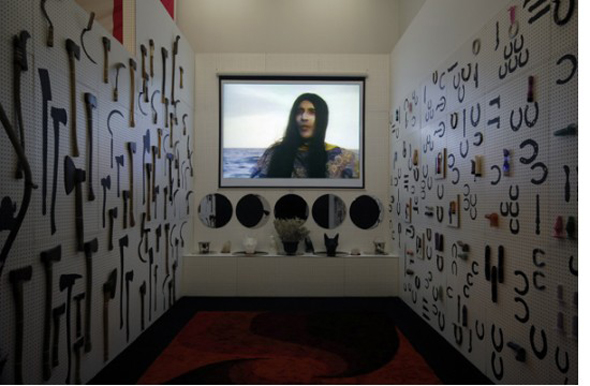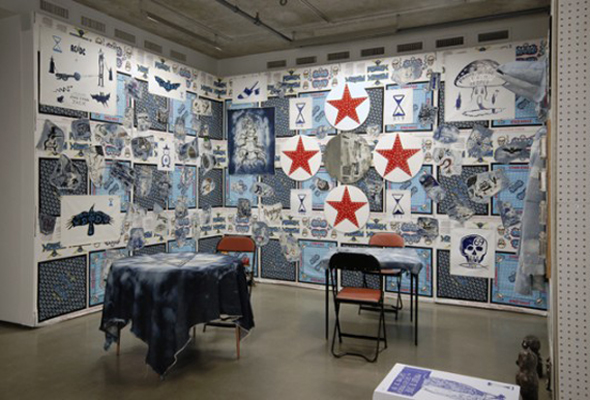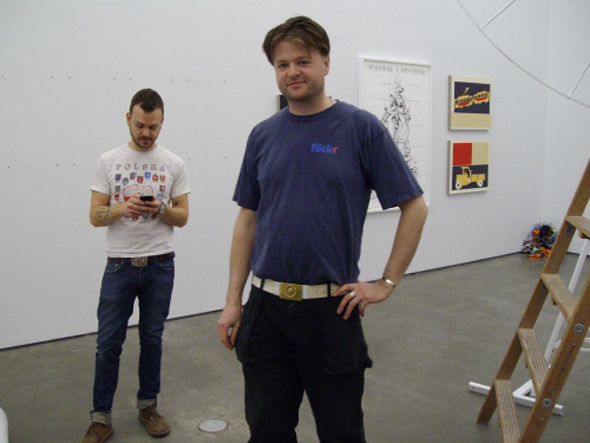
|
THE OPENING is all about introducing the fascinating, quirky and wonderful people working in and around the visual arts in Vancouver. Each week, we'll feature an artist, collective, curator or administrator to delve deep into who and what makes art happen! |
Putting on an exhibition can sometimes require a whole army of people for any number of tasks - from dealing with the artist, to deciding what gets put in the show and where, sponsorship if necessary, etc etc. In all that fuss, people often forget that there is a whole other group of people who put the art on the walls and make that crazy installation dangling from the ceiling actually happen. These people are called Preparators (Preps for short) or Art Handlers. No art institution, however small, can function without a Prep. In New York, they even had their own 'Art Handling Olympics' last year (read about that here). Though Vancouver does not have Art Handler Olympics, we do have a lot of Preps at varying institutions. I sat down with Phil Dion from the Contemporary Art Gallery over beer and wings to discuss the art of handling art.

Installation view of FASTWÜRMS 'DONKY@NINJA@WITCH' at the CAG
Phil Dion. Are you related to Celine [Dion]?
I am apparently!
Really?!
Very far back, maybe five generations ago. Same family in Quebec. My parents were flying out of Rio de Janeiro once, and the attendant behind the counter asked them if they were related to Celine Dion because they were from Canada and named Dion. My Dad said basically the same thing as I did, really vaguely, so far back that it doesn’t matter. But her English wasn’t that good so all she understood was ‘Yes.’ She started crying and bumped them up to first class, and walked them up to the plane, talking to them the whole time about how much she loved Celine Dion.
[laughs] I wish I was loosely related to someone famous because that story is amazing! So you are the Preparator at the Contemporary Art Gallery – tell me what that involves.
It means putting the art up on the walls in the gallery and building things for the exhibition. The artist and the curators come along and tell me what they imagine they would like and my job is basically to figure out how to do it. Sometimes that’s complicated and sometimes it’s not.
So is it just you who does that for the CAG or is there anyone else?
There’s me, and then I work with a guy named Adam, who comes in when we are doing the installs.
What led you to being a Preparator?
I kind of just fell into it. I didn’t study for it or anything like that.
What would you study to do that? Art I guess?
No there’s a course out of UBC – Museum Sciences. It’s part of curatorial. And people at Emily Carr, at least when I was there could take some kind of course at the Charles H Scott Gallery where they were museum techs, but they were students training to do that one day.
So how did you learn the basics?
I started off working at the Vancouver Airport, for their art program, just being someone’s assistant. Then I worked at Denbigh Design, who do it [art handling] for anyone that commercially hires them. That was basically my training there.
What’s your favourite piece of art that you’ve handled?
My favourite installation that I’ve done was probably with FASTWÜRMS at the CAG. That was a lot of fun because it was bananas. They had sent over tons and tons of stuff. There was just stuff everywhere, on every surface, it was really cool.

Installation view of FASTWÜRMS 'DONKY@NINJA@WITCH' at the CAG
So did you decide where things went, or how does that work?
They had a plan and we built some walls. Then they had pre-fabricated stuff – a wall of dildos, a wall of knives and stuff like that. It was just fun because there was so much stuff. It was kind of kooky.
Do you prefer artists who are really hands on with installation? Or people who just want to show up and have it all done? I guess you also work with Jenifer [Papararo, CAG Curator], or whoever is curating a lot.
Yep, I mean really because she’s at the CAG I work with her more than the artists who will show up for maybe two or three weeks to put the art up. I don’t think I have a preference. Working with the artist who is coming up with something on the spot with me more or less, that’s exciting. And then with artists who have a show that’s just coming in crates, we open it up and hang it. That’s really easy. That has it’s advantages too because it’s really straightforward. But it’s more exciting when the artists are producing things at the same time as you're working there.
Like FASTWÜRMS… though I guess that had been installed elsewhere before.
Yeah they hung that first in Toronto. But it had to fit into the space. They installed that in Toronto when the gallery closed in the summer, so they had a month of exclusive installation access to just go crazy in there. And then they packed it up and shipped it to Vancouver. It was still pretty crazy trying to fit that all in here.
Was there less install time here?
Yeah, it was two weeks. Two weeks with some time to take down the previous show. So it’s a week and a half really.
That’s not very much time at all! So if something is very valuable, does it change the way you handle it?Yes. Usually when something’s really valuable, people are watching the way I handle it so it changes the way I do it. Preparators often wear white gloves when they touch things either way.
Do you deal with packing art for shipping?
Sometimes yes. There’s a protocol for packing things to a museum standard. It can be a bit complex. So that I guess is a skill! That’s different from just hanging a photograph on a wall.

Dion during take-down of Roy Arden's 'UNDERTHESUN'
Have you ever broken anything?
Yes. Nothing irreparable though. Working with contemporary art the artists are usually around, and if they’re not around they are usually alive and just make a new one that you pay for. Not the for the sale value of the work though – for it’s production value.
Tell me about a day during install. I guess every artist would be different.
Yeah, every install is different, and that’s what is exciting. Every show has different challenges and problems to solve, and that’s what keeps me interested. An artist comes along with something totally wacky, like they want this giant thing suspended from the gallery ceiling, but no wires. So I have to figure out how to do that. It’s interesting.
Is there a difference between working with a local artist and working with one from away?
Usually the local artist is really involved. They are usually emerging, or at least it’s their first show at the CAG. It is also normally a new show with new work, so they’re excited about putting their work in the CAG and making it to fit that space. They care a lot and are really excited about it, so you end up working and collaborating with them kind of, which is nice. People from out of town, the work is shipped in and the artist shows up and moves things around, but there’s not too much improvisation or creation on site. It’s more straight-forward, which has its advantages like I said earlier.
So when you say you have planning meetings, are you actually planning where things are installed in advance, or is it just the logistics of bringing these pieces in the first place?
Both. Really to decide where things go is the Curator’s job, but we talk about that. He or she will say, oh I want to build a wall here and put this on it. And I’ll say okay, that’s great, or no that wall isn’t strong enough but I can make it stronger, or things like that. They’re the vision side and I am the technical side. I make it happen.
All images courtesy the Contemporary Art Gallery blog and website.


